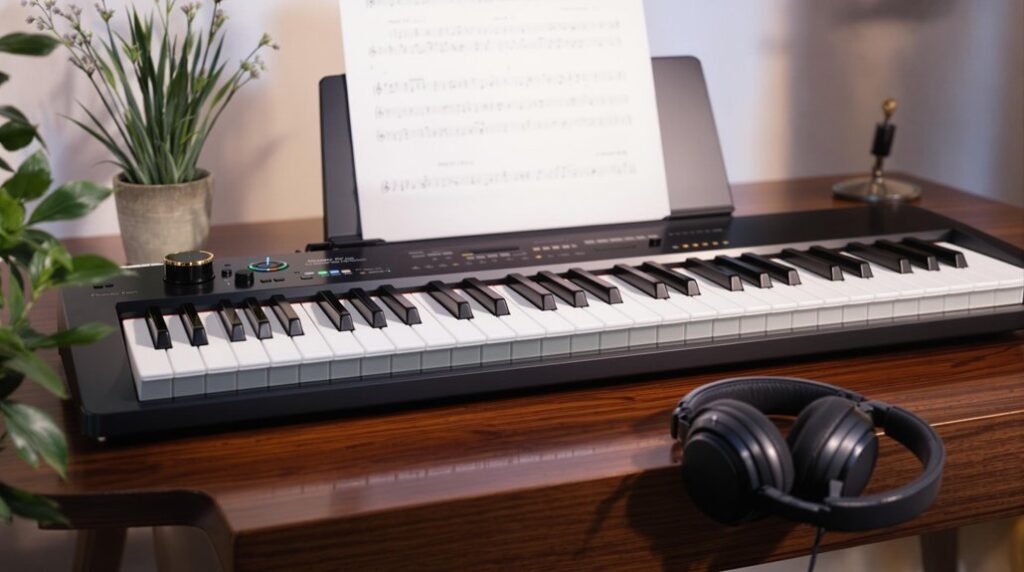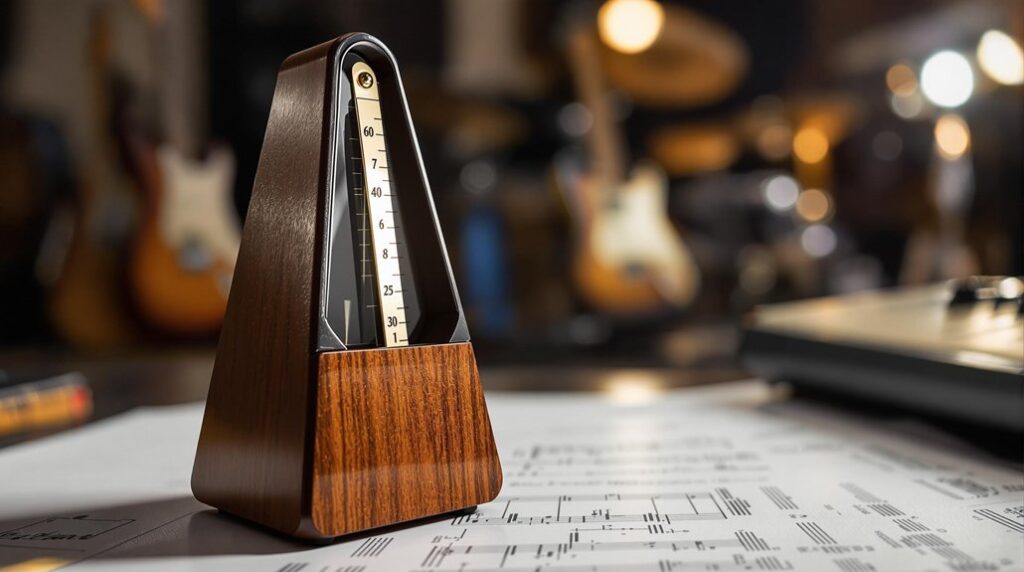Mastering dotted rhythms lets you enhance your musical expressiveness and rhythmic precision. Start by understanding that a dot extends a note’s duration by half its original value. Familiarize yourself with dotted whole, half, quarter, eighth, and sixteenth notes by visualizing them on the staff. Practice clapping and counting these rhythms to internalize them. Gradually incorporate double dotted notes into your practice to tackle more intricate patterns. Knowing the historical context will deepen your appreciation for how dotted rhythms have evolved. By following these steps, you’ll improve your ability to play more sophisticated pieces. More techniques await in the following sections.
Key Takeaways
- Understand the dot’s function: it extends a note’s duration by half its original value.
- Practice clapping and counting rhythms to internalize the timing of dotted notes.
- Start with slower tempos and gradually increase speed to master dotted rhythms.
- Visualize and familiarize yourself with the notation of various dotted notes on the staff.
- Incorporate dotted rhythms into your musical practice to enhance phrasing and dynamics.
Understanding Dotted Notes
Grasping the concept of dotted notes is essential for improving your rhythmic accuracy and musical expressiveness. Dotted notes add complexity and depth to your musical pieces by extending the duration of the note. A dot next to a note increases its length by half its original value. For example, a dotted quarter note lasts as long as a quarter note plus an eighth note.
Understanding these rhythmic nuances is vital. Dotted notes come in various forms, including whole, half, quarter, eighth, and sixteenth notes. Each type adds a distinctive flow and rhythm to your compositions. Double dotted notes, featuring two dots, further extend the note’s duration, creating even more intricate rhythms.
Mastering these performance techniques enhances your ability to convey musical dynamics and subtle changes in a piece. Properly interpreting and executing dotted notes can enhance your phrasing, making your performance more expressive and engaging.
To achieve rhythmic precision, practice counting and clapping dotted rhythms. This will help internalize their timing and make their application in actual performance more natural.
Visual Representation
Visual representation of dotted notes is vital for understanding their impact on musical timing and rhythm. When you see a small dot placed to the right of a note head, it signifies a dotted note. This dot increases the note’s duration by half its original value. For example, a dotted half note equals a half note plus a quarter note.
To master dotted notes, familiarize yourself with their symbol meanings and notation. You’ll encounter dotted whole, half, quarter, eighth, and sixteenth notes. Each type follows the same principle: the dot adds half of the note’s original duration. This is essential in achieving the correct flow, rhythm, and complexity in your music.
Dotted notes appear across different musical genres, from classical to jazz, adding sophistication and importance to various tempos. In classical music, dotted notes often create majestic and grand rhythms, while in jazz, they contribute to syncopation and swing.
To practice, visualize the dotted note on the staff and count its extended value. By doing so, you’ll better grasp how dotted notes influence the piece’s rhythm and complexity. Proper execution enriches your musical interpretation, making your performance more dynamic and engaging.
Double Dotted Notes
Building upon your understanding of dotted notes, double dotted notes take this concept further by adding two dots to the right of a note head, extending its duration significantly. Each dot adds half the value of the preceding note or dot, making double dotted notes a powerful tool in achieving intricate rhythmic patterns and advanced techniques.
Understanding double dotted notes is essential for interpreting complex rhythms in advanced musical pieces. These notes contribute significantly to the richness and complexity of rhythms, allowing you to explore new musical nuances and develop your interpretative skills.
Here’s why mastering double dotted notes can enhance your musical prowess:
- Enhanced Musical Expression: Double dotted notes provide depth and subtlety to your performance, allowing you to express intricate emotions and themes.
- Advanced Rhythmic Patterns: They enable you to tackle sophisticated rhythms that you’d encounter in both classical and contemporary music.
- Improved Interpretative Skills: Correctly executing double dotted notes helps you develop a keen sense of timing and precision.
- Enriched Compositions: Incorporating double dotted notes adds layers and complexity, making your compositions more compelling and engaging.
Practical Application
To effectively apply dotted rhythms in your music, start by practicing counting and clapping to accurately identify the base notes and calculate their extended durations. This foundational step ensures you understand the timing.
Next, subdivide the beat to make counting easier, especially in faster tempos where dotted notes can be tricky.
Incorporate these practice techniques into your routine. Begin with slower tempos, gradually increasing speed as you become comfortable. Use a metronome to maintain consistency.
Clap the rhythm first, then play it on your instrument. This dual approach solidifies your understanding and execution.
For musical interpretation, focus on shaping your phrasing. Dotted rhythms can add variety and expressiveness to your music. Experiment with different dynamics and articulations to see how they enhance the piece. Use dotted notes to create anticipation, build suspense, and emphasize key phrases.
Engage in creative exercises to explore the full potential of dotted rhythms. Compose short pieces or improvisations that heavily feature dotted rhythms. This will help you internalize their use and discover how they can introduce syncopation for dynamic expression.
Historical Context
Dotted rhythms have their roots in the medieval period, where they began to break the rigid rhythmic patterns of the time. During this era, musicians and composers sought ways to add more expressiveness and complexity to their music. The introduction of dotted notes marked a significant shift in musical notation, allowing for greater flexibility and variety in rhythmic structures.
As you explore the medieval origins of dotted rhythms, you’ll notice how they contributed to the rhythmic evolution of music. Over centuries, these rhythms have become fundamental to music theory and practice.
Here’s why you should appreciate the historical context of dotted rhythms:
- Breaking Boundaries: Dotted notes allowed medieval composers to move beyond the strict rhythmic modes, fostering creativity.
- Enriching Music: They added depth and dynamic appeal to compositions, making the music more engaging.
- Reflecting Change: Dotted rhythms mirrored the changing tastes and innovations in music over time.
- Enhancing Emotion: They introduced a lyrical quality, contributing to the overall momentum and emotional impact of a piece.
Understanding the historical context of dotted rhythms not only enriches your knowledge but also enhances your appreciation for their role in shaping the music we enjoy today.
Frequently Asked Questions
How Do You Teach Dotted Rhythms?
To teach dotted rhythms, use engaging teaching techniques and interactive student engagement. Start with simple musical examples, then gradually introduce more complex ones. Implement effective practice strategies, like vocal exercises and chanting, to internalize rhythms.
How to Understand Dotted Notes?
To understand dotted notes, recognize that the dot adds half the note’s original value. This changes the rhythm by extending the duration, making it important for rhythm understanding. Practice different dotted notes to grasp their impact on musical flow.
How to Count Dotted Rhythms?
To count dotted rhythms, start by breaking down the rhythmic patterns. Use counting exercises and metronome drills to internalize the timing. Practice techniques like clapping and tapping can reinforce your understanding and execution of these rhythms.
What Is the Equation for a Dotted Rhythm?
To determine dotted rhythms, use this mathematical interpretation: add the original note value to half of its value. For example, a dotted quarter note equals 1.5 beats (1 beat + 0.5 beat). This approach enhances accuracy and timing.
Conclusion
In mastering dotted rhythms, you’ve explored dotted notes and their visual representation. Dived into double dotted notes and examined their practical applications.
Remember, practice is key. Incorporate these rhythms into your daily practice and soon, they’ll become second nature.
Historically, dotted rhythms have enriched music with complexity and nuance. Embrace this knowledge, and you’ll enhance your musicality.
So, grab your instrument, apply what you’ve learned, and enjoy the rhythmic journey ahead!




